December 2025

The global digital health market size is calculated at USD 335.51 billion in 2024 and is expected to be worth USD 1,080.21 billion by 2034, expanding at a CAGR of 13.1% from 2024 to 2034, as a result of increasing demand for mobile health apps and growing penetration of AI, IoT, and big data.
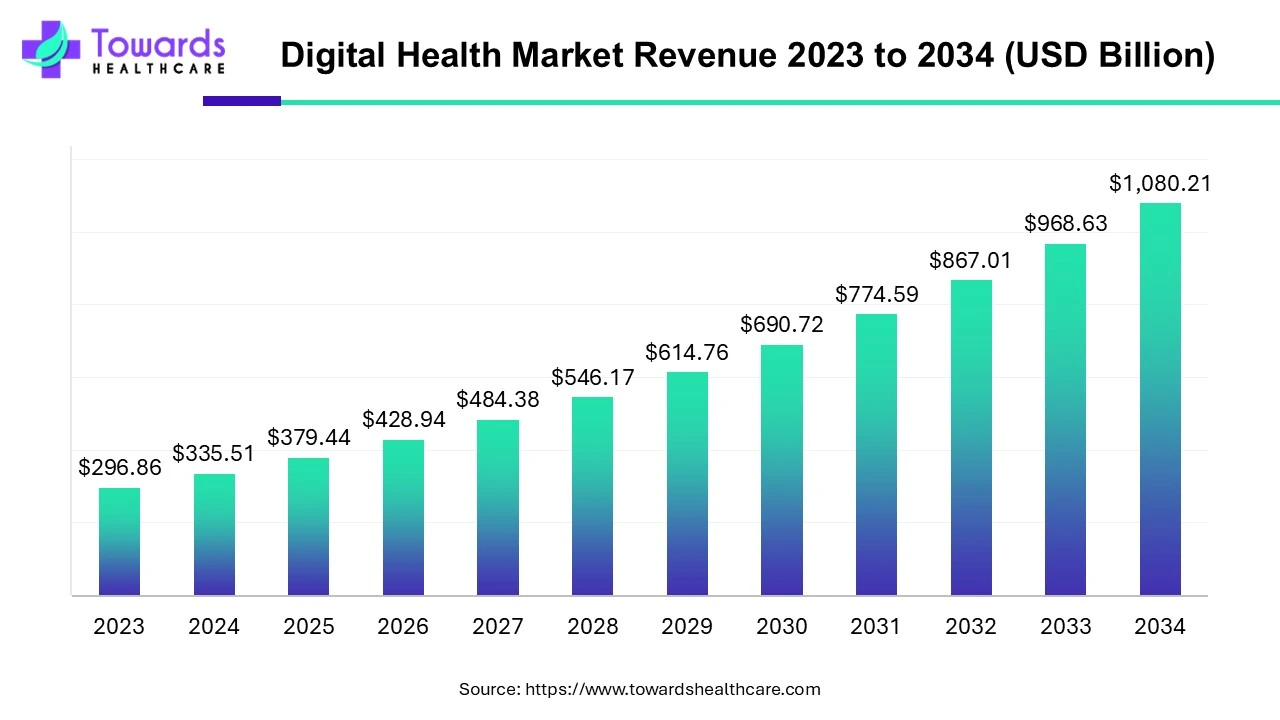
From Healthcare to Health Solutions: Ensuring Effectiveness, Efficiency, Equity and Sustainability for All
The digital health market refers to the use of digital technologies, such as mobile devices, wearable sensors, health information technology, and telehealth, to improve healthcare delivery and patient outcomes. The market encompasses a broad range of products and services, including mobile health apps, remote patient monitoring devices, electronic health records (EHRs), telemedicine, and health analytics.
The digital health market is experiencing significant growth due to several factors, including the increasing adoption of mobile devices and internet connectivity, the need to reduce healthcare costs and improve patient outcomes, and the growing demand for personalized and convenient healthcare services. The COVID-19 pandemic has also accelerated the adoption of digital health technologies, as healthcare providers and patients seek ways to safely and remotely manage healthcare.
The market is expected to continue to grow as advancements in technology, such as artificial intelligence, machine learning, and big data analytics, enable the development of more sophisticated and effective digital health solutions. However, there are challenges to overcome, such as data privacy concerns, interoperability issues, and regulatory oversight.
Cost efficiency stands out as a major driver; before the COVID-19 pandemic, 54% of U.S. adults indicated they would use telehealth services to save money. With continued investments in telehealth, these lower costs are expected to persist, benefiting both patients and providers. Accessibility is another crucial factor, as the demand for convenient healthcare options has surged, particularly among millennials.
Nearly one-third of this demographic finds traditional in-person visits inconvenient, prompting providers to enhance virtual care and online health services to meet this need. Additionally, the shift towards value-based care (VBC), driven by insurers, is reshaping healthcare priorities from the quantity of services to the quality of patient outcomes. Digital tools like AI-enabled analytics are integral to this shift, helping optimize care and maintain cost-efficiency. Together, these elements are driving a profound transformation in how healthcare is delivered and experienced.
The combination of technology and healthcare has led to exponential growth in the digital health business. This industry includes a broad range of advances, such as wearable technology, electronic health records (EHRs), telemedicine, and mobile health apps. Additionally, enhancements in big data analytics and artificial intelligence improve the precision of diagnoses and the customization of treatment regimens. The digital health market is expected to grow further because patient-centered care, connectivity, and data security are becoming more and more important. Both public and private sector investments are fostering innovations aimed at enhancing patient outcomes, healthcare delivery, and overall system efficiency.
Several major themes are likely to influence the direction of the digital health market in the future. Firstly, the combination of machine learning and artificial intelligence (AI) will improve predictive analytics in healthcare and diagnostic accuracy, enabling early disease identification and customized treatment regimens. As telehealth develops, more advanced platforms will enable seamless connection with other healthcare systems and electronic health records (EHRs), enhancing the effectiveness and breadth of virtual care. Ultimately, patient education and engagement will receive more attention, enabling people to actively manage their health with the use of digital tools and services. All of these trends suggest that the healthcare ecosystem will become more integrated, effective, and patient-focused.
Telehealth is the delivery of healthcare services using digital technologies, such as video conferencing, remote monitoring, and mobile health applications. The rise of telehealth has been a game-changer for the healthcare industry, allowing patients to receive care from the comfort of their homes and improving access to care for those in remote or underserved areas.
The growth of telehealth is being propelled by several factors, including the rising demand for healthcare that is convenient, easily accessible, and affordable. Telehealth services allow patients to access care quickly and easily, reducing the need for expensive and time-consuming in-person appointments. This is especially important for those with chronic conditions or mobility issues that make it difficult to travel to a healthcare facility.
Telehealth also offers a more personalized and proactive approach to healthcare, with remote monitoring tools allowing healthcare providers to monitor patients' health status in real-time and intervene as needed. This can lead to earlier diagnosis and treatment of health conditions, improving patient outcomes and reducing the overall cost of care.
In addition, telehealthcare is also being embraced by healthcare providers as a means of improving patient outcomes and reducing healthcare costs. Remote monitoring and teleconsultations can help to prevent hospital readmissions, decrease the length of hospital stays, and improve patient satisfaction. Furthermore, another driving force behind the trend toward telehealth care is the rapid advancements in technology. Mobile devices, wearable technology, and telemedicine software have all made it possible for patients to receive care virtually from anywhere in the world.
Moreover, telehealthcare technology is expected to continue to grow rapidly, driven by factors such as the increasing demand for convenient and cost-effective healthcare, advancements in digital technologies, and the shift towards more personalized and proactive healthcare models.
By technology, the mHealth segment is expected to grow at the fastest CAGR in the market during the forecast period. This is due to the increasing adoption of smartphones and advancements in internet technologies. Mobile health apps are user-friendly, connecting both patients and providers from remote locations. mHealth technology platforms perform multiple functions, such as obtaining vital signs, delivering health-related patient data to healthcare professionals, and allowing remote exams. mHealth enables patients to actively participate in their own clinical decision-making.
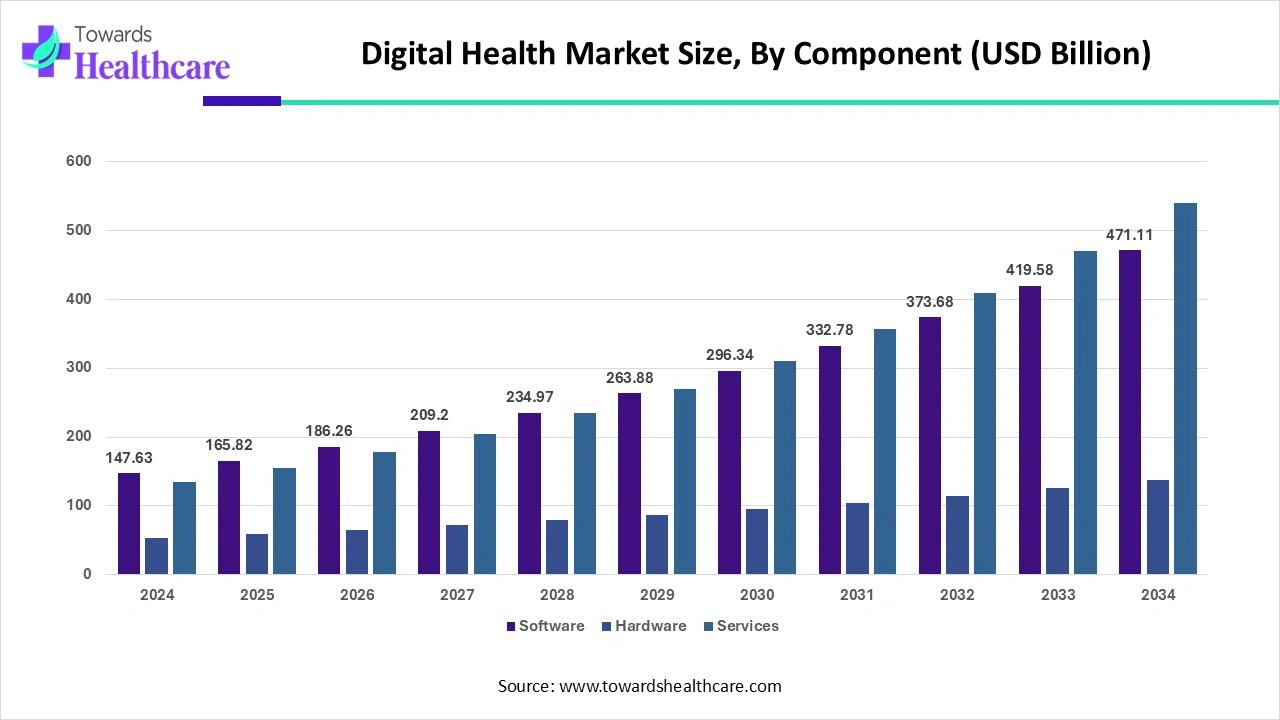
| 2024 | 2025 | 2026 | 2027 | 2028 | 2029 | 2030 | 2031 | 2032 | 2033 | 2034 | |
| Software | 147.63 | 165.82 | 186.26 | 209.2 | 234.97 | 263.88 | 296.34 | 332.78 | 373.68 | 419.58 | 471.11 |
| Hardware | 53.68 | 59.2 | 65.23 | 71.84 | 79.05 | 86.93 | 95.5 | 104.84 | 114.98 | 125.98 | 137.88 |
| Services | 134.2 | 154.44 | 177.68 | 204.35 | 234.96 | 270.09 | 310.39 | 356.61 | 409.61 | 470.38 | 540.04 |
| Total | 335.51 | 379.46 | 429.17 | 485.39 | 548.98 | 620.9 | 702.23 | 794.23 | 898.27 | 1015.94 | 1149.03 |
The healthcare industry is increasingly embracing digital transformation, and the synergy between service and software is a key driver of this shift. Healthcare organizations are recognizing the potential of digital technologies to streamline operations, enhance patient care, and improve outcomes. Digital services such as telehealth, remote patient monitoring, and virtual consultations have gained significant momentum in recent years, particularly with the onset of the COVID-19 pandemic. These services leverage digital technologies such as video conferencing, wearable devices, and mobile apps to provide patients with convenient and accessible care. They also enable healthcare providers to reach patients in remote or underserved areas, which is particularly important in rural communities.
As of 2022, services were the highest contributor to this market, with a 64.00% revenue share, and is anticipated to exhibit a 61.15% market share by 2032, registering a CAGR of 11.5% from 2023 to 2032. While the software segment is projected to witness the fastest growth with a CAGR of 12.5% (2023-2032).
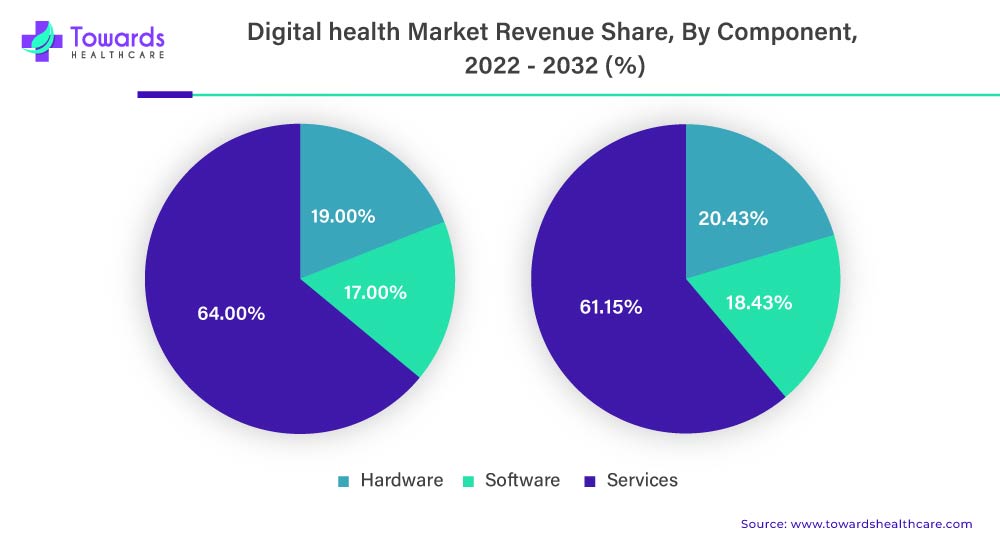
The service segment of the digital health market refers to the various services that are required for the implementation, integration, maintenance, and upgrading of digital health technologies such as electronic health records (EHR), digital imaging, e-prescription services, and enterprise resource planning (ERP) systems.
Another factor contributing to the growth of the service segment is the increasing number of investments in digital infrastructure, particularly in developing countries. This is leading to the adoption of digital health services as a means of establishing successful digital platforms.
Thus, the service segment of the digital health market is expected to grow as the demand for digital health technologies continues to increase. However, the success of this segment will depend on factors such as the cost of implementation and maintenance, the level of adoption by healthcare professionals and organizations, and the overall effectiveness of the technologies in improving patient care.
By component, the software segment is expected to grow with the highest CAGR in the market during the studied years. By leveraging healthcare software in healthcare organizations, providers can access patient data from anywhere and at any time. Providers and patients have complete control over the software, rather than relying on service providers. Software eliminates the need for a specialized infrastructure. AI-based software predicts the future risk of a disease and suggests personalized medicines. It enables continuous monitoring of patients and sends real-time data to providers.
Europe is one of the most significant markets for digital health, with a growing number of startups and established players investing in digital solutions to transform healthcare delivery. The region's aging population, the increasing burden of chronic diseases, and the need for more efficient and cost-effective healthcare services are driving the demand for digital health solutions.
Europe was the highest contributor to this market, with 35.51% revenue share in 2022, and is anticipated to account for 31.31% revenue share by 2032, registering a CAGR of 10.2% from 2023 to 2032. While Asia Pacific is projected to register the fastest growth with a CAFR of 14.1% (2023-2032).
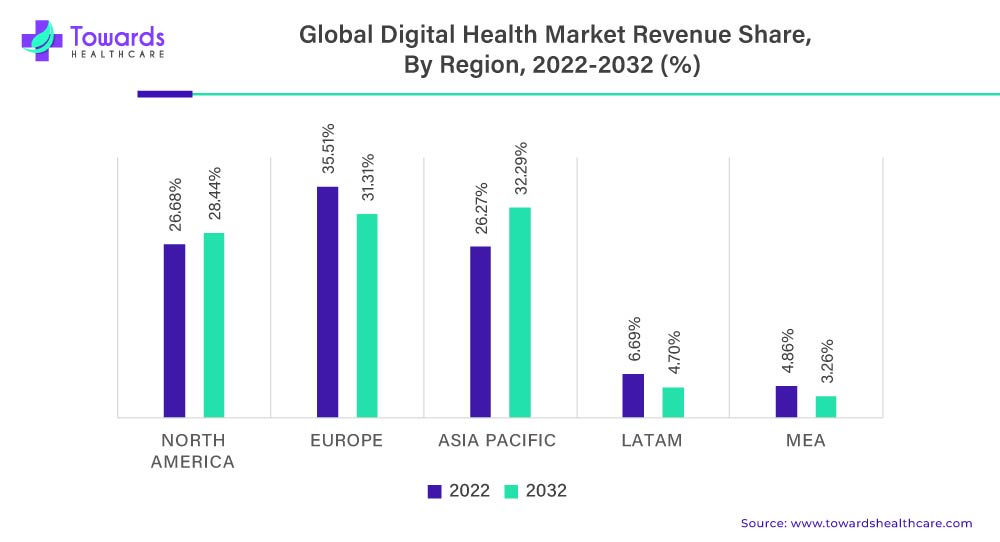
Some of the key digital health solutions in Europe include electronic health records (EHRs), telemedicine, mobile health (mHealth), and health information exchanges (HIEs). The European Union (EU) has also launched initiatives to promote the development and adoption of digital health technologies, such as the Digital Single Market strategy and the European Innovation Partnership on Active and Healthy Ageing.
| By Europe Region | Revenue Share (%) 2022 | Forecasted Revenue Share (%) 2032 |
| UK | 26.75% | 25.93% |
| Germany | 27.89% | 24.97% |
| France | 19.04% | 20.32% |
| Rest of Euorpe | 26.32% | 28.78% |
The COVID-19 pandemic has accelerated the adoption of digital health solutions in Europe, with telemedicine and remote monitoring playing a critical role in delivering care while reducing the risk of infection. The European Commission has also launched a COVID-19 Data Portal to facilitate data sharing and collaboration among researchers, healthcare professionals, and policymakers.
However, Europe's digital health market also faces challenges, including the lack of interoperability and standardization of digital health solutions across different countries and regions. Data privacy and security concerns also need to be addressed to ensure patient trust and confidence in digital health technologies. The regulatory environment for digital health solutions also varies across different countries, which can hinder innovation and investment in the sector.
Despite these challenges, the digital health market in Europe is poised for significant growth, driven by the increasing demand for more efficient and patient-centered healthcare services. The region's strong focus on research and development and the availability of funding and support for digital health startups also make it an attractive market for investors and entrepreneurs.
Germany Market Trends
The Digital Act by the German government supports the use of digital tools and technologies in the healthcare sector. According to a recent survey study conducted on 4,464 adults aged 18 years or above, about 19.3% of people owned consumer wearables. Of these, 77.8% of adults used their wearables to collect health data.
UK Market Trends
In the UK, more than 28 million people use the NHS app, and over 40 million people have an NHS login. The UK government announced an investment of £150 million in funding for digital adoption in healthcare organizations. It has also made plans to invest £2 billion to support electronic patient records in all NHS trusts.
| By Asia Pacific Region | Revenue Share (%) 2022 | Forecasted Revenue Share (%) 2032 |
| China | 32.06% | 31.32% |
| Japan | 12.41% | 11.31% |
| India | 10.34% | 12.84% |
| South Korea | 8.57% | 8.05% |
| Southeast Asia | 11.34% | 12.04% |
| Rest of Asia Pacific | 25.28% | 24.44% |
The Asia Pacific region is seeing the fastest growth in telehealth services, driven by a number of factors including increasing demand for healthcare services, expanding internet and smartphone usage, and rising healthcare costs. Countries like China, Japan, and South Korea are at the forefront of this trend, with large investments being made in digital health infrastructure and initiatives to promote telehealth adoption.
In recent years, the Asia Pacific region has emerged as a significant player in the digital health market, with telehealth services being a major growth driver. The region's rapidly aging population, increasing prevalence of chronic diseases, and rising healthcare costs have created a demand for innovative healthcare solutions, leading to the adoption of digital health technologies. Countries like China, Japan, and South Korea are investing heavily in digital health infrastructure, including the development of telehealth platforms, to improve access to healthcare services and reduce the burden on their healthcare systems. In China, for example, the government has launched several initiatives to promote telemedicine, including a policy that allows doctors to practice across multiple provinces and a telemedicine network that connects medical institutions across the country.
Japan Market Trends
In Japan, the government has been promoting the use of telehealth to improve access to healthcare services in rural areas, where there is a shortage of doctors. The country has also been investing in digital health startups and providing funding for research and development in the field of telehealth.
China Market Trends
The increasing patient population and the rising adoption of advanced technologies promote the use of wearable devices or health apps in China. China is home to over 2,624 health tech startups. Fangzhou, Inc. is a leading online chronic disease management platform in China that serves 49.2 million registered users and 223,000 physicians as of December 2024.
North America is estimated to host a significantly growing digital health market during the forecast period. This is due to the increasing demand for telemedicine as well as remote monitoring. This is further supported by the regulatory bodies and the government as well. Thus, this in turn promotes the market growth.
The rising prevalence of chronic disorders and the growing demand for personalized medicines contribute to market growth. As of July 2025, the U.S. FDA has approved a total of 1,247 AI/ML-based medical devices. Apart from this, the presence of key players and the increasing adoption of electronic health records also foster market growth.
U.S. Market Trends
The U.S. digital health market was valued at $79.14 billion in 2024 and is expected to grow to $88.38 billion in 2025. Looking ahead, it could reach nearly $238.65 billion by 2034, growing at an average annual rate of 11.67% over the forecast period.
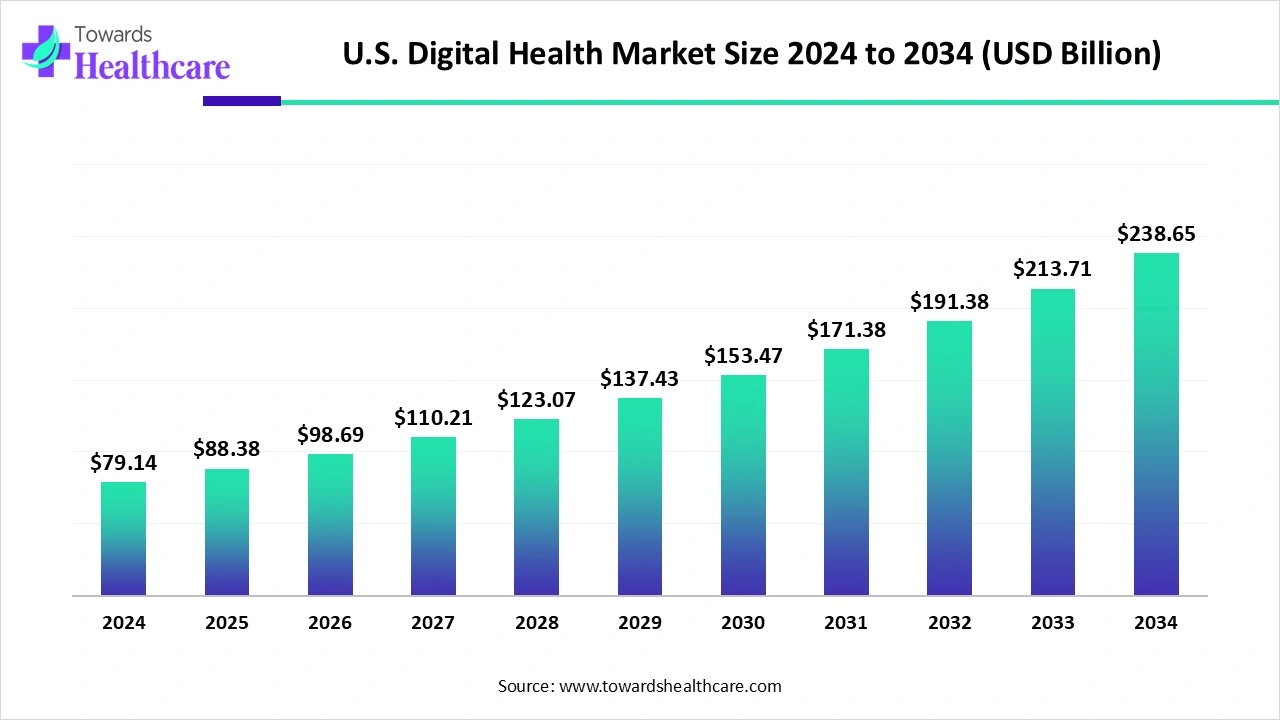
The demand for the use of telemedicine is driving the market in the U.S. At the same time, the aging population, as well as severely ill patients, are also using it for their treatment follow-ups. It also reduces hospital visits, which enhances the comfort of the patients.
Canada Market Trends
Canada is experiencing a rise in the use of remote monitoring systems as well as telemedicine. Thus, this increases the demand within the population, increasing its manufacturing process. This is further supported by the government investment. At the same time, compliance with the regulations of regulatory bodies enhances the trust and safety of the patients, improving patient outcomes.
Mobile apps are transforming healthcare by providing patients with convenient access to information, resources, and tools that can help them manage their health and well-being. These apps can be used for a wide range of purposes, including tracking fitness goals, monitoring chronic conditions, accessing medical records, and scheduling appointments.
Mobile health apps have seen significant growth in recent years, particularly in the area of chronic disease management. These apps offer patients the ability to track and manage their symptoms, monitor their medications, and communicate with their healthcare providers more easily. This can lead to improved health outcomes, better medication adherence, and reduced healthcare costs. In addition, the availability of wearable technology such as fitness trackers and smartwatches has further enhanced the potential for mobile health apps to support chronic disease management. As the prevalence of chronic diseases such as diabetes and hypertension continue to rise, the demand for these apps is expected to grow. For example, diabetes management apps can track blood glucose levels, provide reminders to take medication, and even suggest healthy meal options.
Furthermore, another area of growth for mobile health apps is in mental health. Apps for stress management, meditation, and mindfulness have become increasingly popular, providing users with tools to manage their mental health and well-being. Mobile apps are also being used for telehealth services, allowing patients to have virtual consultations with healthcare providers from the comfort of their own homes. This can be especially beneficial for individuals who live in remote or rural areas and have limited access to healthcare services.
Moreover, mobile health apps are providing patients with more control over their health and well-being, while also improving the efficiency and accessibility of healthcare services. As technology continues to evolve, we can expect to see even more innovative mobile health solutions in the future.
Cybersecurity has become a major concern in the healthcare industry, as more and more patient data is being digitized and stored in electronic health records (EHRs). These records contain sensitive information such as medical histories, diagnoses, and treatment plans, making them an attractive target for hackers and cybercriminals.
Protecting sensitive health information from cyber threats is a significant challenge for the healthcare industry, particularly due to the massive amount of data generated and stored every day. Healthcare organizations need to take necessary measures to ensure the security and confidentiality of patient data, as well as prevent unauthorized access, data breaches, and cyberattacks. They need to implement robust security measures, such as firewalls, encryption, multi-factor authentication, and regular security audits to safeguard their IT systems and networks from cyber threats. Additionally, staff training and awareness programs can also play a crucial role in maintaining cybersecurity in healthcare organizations.
Another challenge is the constantly evolving nature of cyber threats. Hackers are constantly developing new tactics and techniques to breach healthcare systems, and healthcare organizations must keep up with these developments to ensure their systems remain secure. Additionally, there is a shortage of cybersecurity professionals with expertise in healthcare. This makes it difficult for healthcare organizations to find the right talent to address their specific cybersecurity needs.
To address these challenges, healthcare organizations must prioritize cybersecurity and implement comprehensive security measures to protect patient data. This includes everything from firewalls and antivirus software to encryption and multi-factor authentication. Regular security assessments and audits should also be conducted to identify vulnerabilities and ensure that security measures are up to date. And finally, healthcare organizations must invest in educating their staff about cybersecurity best practices and the importance of maintaining strong security protocols.
The digital health revolution is not limited to developed economies but also presents significant opportunities for growth in emerging economies. Emerging economies are characterized by large and diverse populations, growing middle classes, and a rising burden of non-communicable diseases. These factors have led to increased demand for healthcare services and a growing interest in digital health solutions.
The proliferation of mobile phones and internet connectivity is one of the primary factors driving the growth of digital health in emerging economies. Mobile phones have become ubiquitous in many emerging economies, and this has created opportunities for mobile health (mHealth) solutions. mHealth solutions are being used to deliver a range of services, including health education, disease management, and remote consultations. These solutions are often low-cost and can be accessed by people who do not have regular access to traditional healthcare services.
In addition, the growing interest in health insurance is driving digital health adoption in emerging economies. As more people in these economies become middle class, they are seeking access to affordable and comprehensive health insurance. Digital health solutions, such as telemedicine and remote monitoring, can help to make healthcare more accessible and affordable for these populations.
Furthermore, the digital health revolution presents significant opportunities for growth in emerging economies. By leveraging mobile technology and other digital solutions, healthcare providers in these economies can deliver more accessible, affordable, and effective healthcare services to their populations.
Let's see how top Companies are transforming the Digital Health Market: https://www.towardshealthcare.com/companies/digital-health-market-companies
Nalla Karunanithy, CEO, Aster Digital Health & E-Commerce business commented that digital transformation is the future of healthcare in the Middle East which is proven by the remarkable growth of their application, myAster. Data and digital innovation can transform the healthcare landscape, setting new standards for convenience, quality, and care in the industry.
By Component
By Technology
By Geography
December 2025
November 2025
November 2025
November 2025